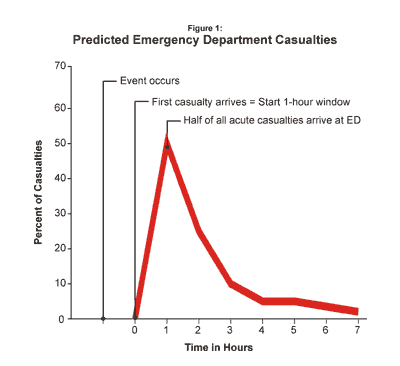Mass Casualties Predictor
In the confusion that often follows a mass casualty event, managing a hospital can be challenging. Past mass casualty events show patterns of hospital use. It is possible to estimate initial casualty volume and pattern after a mass casualty event. Public health professionals and hospital administrators can use this information to handle resource and staffing issues during a mass casualty event.
Patterns of Hospital Use
- Within 90 minutes following an event, 50-80% of the acute casualties will likely arrive at the closest medical facilities.
- Other hospitals outside the area usually receive few or no casualties.
- The less-injured casualties often leave the scene under their own power and go to the nearest hospital. As a result:
- They are not triaged at the scene by Emergency Medical Services (EMS).
- They may arrive to the hospital before the most injured.
- On average, it takes 3-6 hours for casualties to be treated in the emergency department (ED) before they are admitted to the hospital or released.
Casualty Predictor
When trying to determine how many casualties a hospital can expect after a mass casualty event, it is important to remember that casualties present quickly and that approximately half of all casualties will arrive at the hospital within a 1-hour window.
- This 1-hour window begins when the first casualty arrives at the hospital.
- To predict the total number of casualties your hospital can expect, double the number of casualties the hospital receives in the first hour.
Casualty Predictor
Total Expected Casualties = (Number of casualties arriving in one hour window) x 2
Note: The total expected number of casualties will be an estimate. There are many factors that may affect the accuracy of this prediction such as: transportation difficulties and delays, security issues that may hinder access to victims, and multiple explosions or secondary effects of explosion (such as a building collapse).
- Page last reviewed June 13, 2006
- Page last updated May 9, 2003
- Content source: National Center for Injury Prevention and Control (NCIPC), Coordinating Center for Environmental Health and Injury Prevention (CCEHIP)
Get email updates
To receive email updates about this page, enter your email address:
Contact Us:
- Centers for Disease Control and Prevention
1600 Clifton Rd
Atlanta, GA 30333 - 800-CDC-INFO
(800-232-4636)
TTY: (888) 232-6348
24 Hours/Every Day - cdcinfo@cdc.gov


